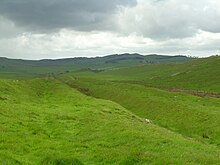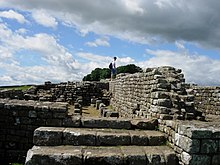Benutzer:Ratheimer/Hadrianswall2
Construction[Bearbeiten | Quelltext bearbeiten]
Construction probably started in 122 AD and was largely completed within eight years. Construction started in the east and proceeded westwards, with soldiers from all three of the occupying Roman legions participating in the work. The route chosen largely paralleled the nearby Stanegate road from Luguvalium (Carlisle) to Coria (Corbridge), which was already defended by a system of forts, including Vindolanda. The Wall in part follows the outcrop of a harder, more resistant igneous diabase rock escarpment, known as the Great Whin Sill.
The initial plan called for a ditch and wall with eighty small gated milecastle fortlets, one placed every Roman mile, holding a few dozen troops each, and pairs of evenly spaced intermediate turrets used for observation and signalling. The wall was initially designed to a width of three metres (10 feet) (the so-called "Broad Wall"). The height is estimated to have been around 5 or 6 metres (16 to 20 feet). Local limestone was used in the construction, except for the section to the west of Irthing where turf was used instead, as there were no useful outcrops nearby. The turf wall was six metres wide (20 feet) and around 3.5 metres (11.5 feet) high. Milecastles in this area were also built from timber and earth rather than stone but turrets were always stone. The Broad Wall was initially built with a clay-bonded rubble core and mortared dressed rubble facing stones, but this seems to have made it vulnerable to collapse and repair [missing word] with a mortared core was sometimes necessary.

The milecastles and turrets were of three different designs, depending on which Roman legion built them — inscriptions of the Second, Sixth, and Twentieth Legions, tell us that all were involved in the construction. All were about 493 metres (539 yards) apart and measured 4.27 square metres (46.0 square feet) internally.
Construction was divided into lengths of about 5 miles (8 km). One group of each legion would excavate the foundations and build the milecastles and turrets and then other cohorts would follow, building the wall itself.
Early in its construction, just after reaching the North Tyne, the width of the wall was narrowed to 2.5 metres (8.2 feet) or even less (sometimes 1.8 metres) (the "Narrow Wall"). However, Broad Wall foundations had already been laid as far as the river Irthing, where the Turf Wall began, demonstrating that construction worked from east to west. Many turrets and milecastles were optimistically provided with stub 'wing walls' in preparation for joining to the Broad Wall, offering a handy reference for archaeologists trying to piece together the construction chronology.
Within a few years it was decided to add a total of 14 to 17 (sources disagree) full-sized forts along the length of the wall, including Vercovicium (Housesteads) and Banna (Birdoswald), each holding between 500 and 1,000 auxiliary troops (no legions were posted to the wall). The eastern end of the wall was extended further east from Pons Aelius (Newcastle) to Segedunum (Wallsend) on the Tyne estuary. Some of the larger forts along the wall, such as Cilurnum (Chesters) and Vercovicium (Housesteads), were built on top of the footings of milecastles or turrets, showing the change of plan. An inscription mentioning early governor Aulus Platorius Nepos indicates that the change of plans took place early on. Also some time still during Hadrian's reign (i.e., before AD 138) the wall west of the Irthing was rebuilt in sandstone to basically the same dimensions as the limestone section to the east.

After the forts had been added (or possibly at the same time), the Vallum was built on the southern side. It consisted of a large, flat-bottomed ditch six metres (20 feet) wide at the top and three metres (10 feet) deep bounded by a berm on each side 10 metres (33 feet) wide. Beyond the berms were earth banks six metres (20 feet) wide and two metres (6.5 feet) high. Causeways crossed the ditch at regular intervals. Initially the berm appears to have been the main route for transportation along the wall.
The Wall was thus part of a defensive system which, from north to south included:
- a glacis and a deep ditch
- a berm with rows of pits holding entanglements
- the curtain wall itself
- a later military road (the "Military Way")
- a north mound, a ditch and a south mound to prevent or slow down any raids from a rebelling southern tribe.
Roman-period names[Bearbeiten | Quelltext bearbeiten]


The Latin and Romano-Celtic names of some of the Hadrian's Wall forts are known, from the Notitia Dignitatum and other evidence:
- Segedunum (Wallsend)
- Pons Aelius (Newcastle on Tyne)
- Condercum (Benwell Hill)
- Vindobala (Halton Chesters)[1]
- Hunnum (Rudchester)[1]
- Cilurnum (Chesters aka Walwick Chesters)[1]
- Procolita (Carrowburgh)
- Vercovicium (Housesteads)
- Aesica (Great Chesters)[1]
- Magnis (Carvoran)
- Banna (Birdoswald)
- Camboglanna (Castlesteads)
- Uxelodunum (Stanwix. Also known as Petriana)
- Aballava (Burgh-by-Sands)
- Coggabata (Drumburgh)
- Mais (Bowness-on-Solway)
Outpost forts beyond the Wall include:
Supply forts behind the wall include: